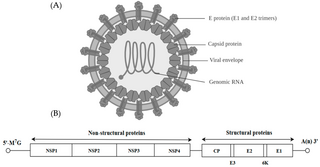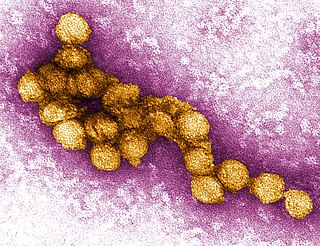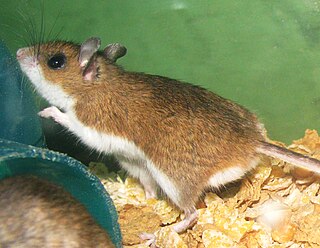Structural and non-structural proteins
Genomic RNA of pestiviruses is translated into a large polyprotein that is divided into several proteins. It has a single big open reading frame (ORF) that can encode roughly 4000 amino acids and a positive-sense ssRNA genome. Among the structural proteins that are N terminal in this polyprotein are three glycoproteins, which are referred to as E0, E1, and E2 depending on the order in which they end up appearing in the polyprotein. [13] The nucleocapsid protein C and the three envelope glycoproteins Erns, E1, and E2 are the virion's structural components. [14] Beginning with a nascent cleavage between the precursor ErnsE1E2 and the capsid protein, glycoprotein processing is then carried out by cleavage at the C-terminal end of E2. [14] After being split into ErnsE1 and E2, ErnsE1 is then transformed into Erns and E1. A host signal peptidase located in the endoplasmic reticulum's lumen catalyzes the cleavage between Erns and E1, as well as that between E1 and E2 (ER). [15] A new type of signal peptidase cleavage site is identified in an RNA virus polyprotein. The most important structural protein is E2, which regulates cell tropism by interacting with cell surface receptors and inducing responses from cytotoxic T-lymphocytes and neutralizing antibodies. E2 is a type I transmembrane protein and has a mass of 55 kDa. All three glycoproteins aid in the attachment of the virus and its entry into target cells. Viral entry and contagiousness require heterodimeric E1-E2 molecules. E1 is categorized as a type I transmembrane protein and has a mass of 33 kDa. Of the three glycoproteins, the functions of E1 are the least developed and least understood. [16] A virus's glycoproteins must perform a variety of tasks throughout its life cycle in order for the virus to successfully infect cells or animals, multiply, and then leave the affected cells. These activities can be broken down into the three mutually exclusive categories of interacting with hosts to sustain itself throughout the animal population, interacting with cells to infect and replicate, and connecting with other viral proteins to form viable virions. Although it lacks a hydrophobic anchor sequence, the structural glycoprotein E(rns) of pestiviruses has been found to be connected to the virion and to membranes in infected cells via its COOH terminus. Erns, an envelope glycoprotein, was recently recognized as an RNase. RNases have a variety of biological effects. They have been proven to be immunosuppressive, neurotoxic, and antihelminthic. Erns severely reduced the protein synthesis of various kinds of lymphocytes without causing cell membrane damage. [17] Symptoms of pestivirus infections include leukopenia and immunosuppression. In the pathogenesis of pestiviruses, ERNS is crucial. A pestivirus envelope glycoprotein called ERNS is crucial for virus attachment and cell infection. Erns lacks a transmembrane domain, unlike the other two envelope proteins E1 and E2, and a significant amount is secreted into the medium of infected. Erns's C-terminus serves as a membrane anchor, a retention/secretion signal, a binding site for cell surface glycosaminoglycans (GAGs), a signal peptidase cleavage site, and more. Erns has a mass of 44–48 kDa. [18] The protein is also present in some pure pestivirus virions, which begs the crucial and fascinating question of how it attaches to the pestivirus envelope. Virus-neutralizing antibodies primarily target the pestivirus E2 glycoproteins, which also function in receptor binding and host range limiting. At the moment where pestiviruses enter cells, their host specificity is probably influenced by the sequence and structure of E2. Enveloped viruses have created a variety of crafty invasion methods. [19] For cell attachment and membrane fusion to occur, one or more viral envelope glycoproteins are required. In contrast to pestiviruses and hepacivirus, which both have two envelope glycoproteins, E1 and E2, members of the Flaviviridae family, such as flaviviruses, only have one glycoprotein, E, in their envelope. Although E2 participates in cell attachment, it is not yet known which protein causes membrane fusion. [20]
The bovine viral diarrhea virus (BVDV) is what causes bovine viral diarrhea (BVD). Bovine viral diarrhea virus type 1 (BVDV-1), Bovine viral diarrhea virus type 2 (BVDV-2), Border disease virus (BDV), and Classical swine fever (CSF) virus are the four recognized species in the genus Pestivirus of the family Flaviviridae. [21] Although progress has been made in recent decades in identifying the activities of the BVDV NSPs, research on the virus still mostly focuses on its structural protein. Understanding BVDV non-structural proteins would assist researchers to better comprehend viral replication and the molecular basis of viral persistent infection. Eight non-structural proteins (NSPs) are encoded by the bovine viral diarrhea virus (BVDV) (i.e., Npro, p7, NS2, NS3, NS4A, NS4B, NS5A, and NS5B). A single open reading frame is encoded by a singular, single-stranded, positive-stranded RNA of 12.3–16.5 kb in the BVDV (ORF). The coding sequence is NH2, and the ORF can be split into various parts to encode polyproteins. –Npro (p20) (p20) –C (p14) (p14) -Erns/E0(gp48), -E1(gp25), -E2(gp53), -p7, NS2(p54), -NS3(p80), -NS4A(p10), -NS4B(p30), -NS5A(p58), -NS5B(p75), -COOH. Individually or collectively, these proteins are involved in viral replication, transcription, and translation. Npro (p20), a protein specific to pestivirus with a molecular weight of roughly 20 kDa, is the first protein generated from the N-terminus of the viral polyprotein. BVDV Npro is a hydrophilic outer membrane protein that primarily consists of beta-sheets and random curling. [22] It lacks a signal peptide. Npro is also a self-protease that can catalyze the breakdown of developing polyproteins to create the BVDV C protein. Infected animals have innate immune suppression as a result of BVDV Npro's capacity to control the generation or inhibition of type I interferon (IFN-I) and alter the virus' ability to replicate. A 6-7 kDa polypeptide generated from E2 called viral protein p7 has two domains. The other domain, which is present throughout infection in the cell as free p7 or E2-p7, is released by signal peptidase interpretation and is found at the C-terminus of E2 without being cleaved. However, because p7 was not found in BVDV particles, it was categorized as a non-structural protein. Although BVDV p7 can aid in the production of contagious BVDV particles and encourage virus release, the exact mechanisms behind these actions are still unknown. [23] With 450 amino acids, NS2 (p54) is a cysteine protease. A shared domain of the C-terminal protease structure and a hydrophobic N-terminal half-anchored protein membrane make up this structure. [24] NS2-NS3 cleavage is mediated by the self-protease in NS2, which may effectively cleave into NS2 and NS3 in the early stages of infection, and the degree of NS2-NS3 cleavage controls BVDV from RNA replication to morphological alterations. [25] Additionally, when the BVDV virus infects a cell, the cell chaperone DNAJC14 joins forces with the viral NS2-NS3 to facilitate the activation of the NS2 protease and the release of NS3, which facilitates the production of virions. [26] As a target antigen for ELISA BVDV detection, NS3 is a multifunctional protein with serine protease activity, helicase activity, and nucleoside triphosphatase (NTPase) activity. [13] Although it plays a significant role in the BVDV replicase and controls the viral RNAs ability to replicate, NS3 has little impact on the assembly of the virus. Only in the NS3/NS4A complex can the NS3 protease reach peak activity, after which the C-terminus of NS3 cleaves all downstream proteins. The replication of viral RNA will be hampered by the inactivation of the NS3 protease, helicase, and NTPase. Normal detection limits for the NS2-NS3 (p125) protein in Ncp and Cp BVDV-infected cells are 120 kDa. The cleavage of NS2-NS3 is connected to the replication of the virus in the early stages of virus infection. [13] A complex known as NS2-NS3/NS4A (NS2-3/4A) is created when NS4A joins with uncleaved NS2-NS3 (NS2-3) or NS3/NS4A. It can be utilized to support RNA replication and virus assembly as the fundamental element of virus particles. In the NS3/NS4A serine protease complex, NS4A functions as a protease cofactor, engaging with NS3 to catalyze the cleavage of downstream proteins NS4B, NS5A, and NS5B. [27] In particle assembly, NS2 and NS3 can replace uncut NS2-NS3 molecules, but the precise mechanism is still unknown. [13] A 35 kDa hydrophobic protein with NTPase activity called NS4B (p30) is involved in the replication of the BVDV genome. [28] Due to interactions between the viral Npro, Erns, and NS4B and the host immune signaling pathways, BVDV can bypass the host immune response and cause persistent infection in cattle by blocking their innate immune responses. [29] The primary target for the diagnosis of diseases, the creation of vaccines, and the management of infections is NS4B. After viral infection, NS4B can trigger humoral and cellular immune responses thanks to its highly conserved epitopes. NS5B (p75), which features a functional motif typical of viral RNA-dependent RNA polymerase, is roughly 77 kDa in size (RdRp). It primarily participates in the process of virus-infected cell membrane rearrangement and catalyzes the creation of viral RNA. [30] The C-terminus of the BVDV polyprotein is where the NS5A (p58) and NS5B (p75) are separated. Infected cells typically contain NS5A (p58) as a single protein or as an uncleaved NS5A-NS5B complex. A hydrophilic, phosphorylated protein with a molecular weight of 58 kDa called NS5A is a part of the viral replicase. [31] Although NS5B has a significant impact on RNA replication, its lack of specificity may have an impact on the design of viral replicase. [32] A number of issues, including the pathogenic mechanism, the regulation of virus replication, and the interaction between p7, NS4B, NS5A, and other NSP, remain unresolved. [33]












